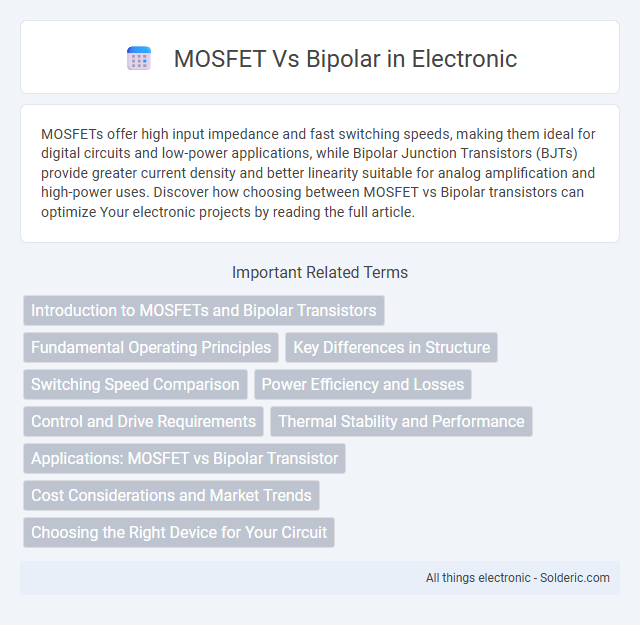MOSFETs offer high input impedance and fast switching speeds, making them ideal for digital circuits and low-power applications, while Bipolar Junction Transistors (BJTs) provide greater current density and better linearity suitable for analog amplification and high-power uses. Discover how choosing between MOSFET vs Bipolar transistors can optimize Your electronic projects by reading the full article.
Comparison Table
| Feature | MOSFET | Bipolar Junction Transistor (BJT) |
|---|---|---|
| Type | Voltage-controlled device | Current-controlled device |
| Control Terminal | Gate | Base |
| Input Impedance | Very high (~10^12 O) | Low (kO range) |
| Switching Speed | High (faster switching) | Moderate (slower switching) |
| Conduction Type | Unipolar (electrons or holes) | Bipolar (electrons and holes) |
| Power Dissipation | Lower due to high efficiency | Higher due to voltage drop across junctions |
| Thermal Stability | Better thermal stability | Prone to thermal runaway |
| Applications | Power amplifiers, digital circuits, switching regulators | Analog circuits, audio amplifiers, switching applications |
| Noise | Lower noise generation | Higher noise compared to MOSFET |
| Packaging Density | Higher integration density | Lower integration density |
Introduction to MOSFETs and Bipolar Transistors
MOSFETs (Metal-Oxide-Semiconductor Field-Effect Transistors) operate through voltage-controlled channels, offering high input impedance and fast switching suitable for digital circuits. Bipolar Junction Transistors (BJTs) are current-controlled devices relying on electron and hole injection, providing high gain and linear amplification ideal for analog applications. Understanding these fundamental differences guides their selection based on switching speed, power efficiency, and amplification needs in electronic designs.
Fundamental Operating Principles
MOSFETs operate as voltage-controlled devices using an electric field to modulate conductivity between the source and drain terminals, enabling fast switching and high input impedance. Bipolar Junction Transistors (BJTs) function as current-controlled devices, relying on the injection and control of minority carriers in the base region to amplify current between the collector and emitter. Your choice between MOSFET and Bipolar depends on the application's demand for speed, input impedance, and current handling capabilities.
Key Differences in Structure
MOSFETs utilize a metal-oxide-semiconductor gate to control current flow through an insulated gate, offering high input impedance and fast switching. Bipolar Junction Transistors (BJTs) rely on current injected into the base region to control the larger current between collector and emitter, resulting in lower input impedance and slower response. Your choice between MOSFET and bipolar devices depends on the required switching speed, input impedance, and application-specific performance criteria.
Switching Speed Comparison
MOSFETs offer significantly faster switching speeds than bipolar transistors due to their majority carrier operation, which eliminates charge storage delays inherent in bipolars. This results in lower switching losses and higher efficiency in high-frequency applications such as DC-DC converters and RF amplifiers. Your choice of MOSFET can enhance performance where rapid on/off transitions are critical for optimal system responsiveness.
Power Efficiency and Losses
MOSFETs generally offer higher power efficiency and lower conduction losses compared to Bipolar Junction Transistors (BJTs) due to their majority carrier operation, which reduces resistive losses during switching. Bipolar transistors exhibit higher saturation voltage, leading to increased power dissipation and thermal stress in high current applications. Choosing a MOSFET for your design can significantly improve energy efficiency, especially in switching power supplies and motor drivers.
Control and Drive Requirements
MOSFETs require voltage-driven gate control with minimal current, enabling efficient high-speed switching and lower power loss in your electronic circuits. Bipolar transistors need current-driven base control, resulting in higher drive power consumption and slower switching speed compared to MOSFETs. This fundamental difference impacts the choice of driver circuitry and overall system efficiency in power electronics applications.
Thermal Stability and Performance
MOSFETs exhibit superior thermal stability compared to bipolar transistors due to their positive temperature coefficient, which prevents thermal runaway by reducing current flow as temperature rises. Bipolar transistors, with a negative temperature coefficient, are more susceptible to thermal runaway, requiring additional circuitry for thermal management. In high-frequency and high-efficiency applications, MOSFETs outperform bipolars by offering faster switching speeds, lower gate drive power, and better heat dissipation capabilities.
Applications: MOSFET vs Bipolar Transistor
MOSFETs dominate in high-speed switching applications such as power supplies, motor controllers, and RF amplifiers due to their high input impedance and fast switching capabilities. Bipolar transistors excel in analog circuits including audio amplifiers and low-frequency applications because of their high current gain and linearity. Your choice depends on whether you prioritize switching efficiency and high frequency (MOSFET) or signal amplification and linearity (Bipolar).
Cost Considerations and Market Trends
MOSFETs generally offer lower manufacturing costs and higher efficiency in high-frequency applications compared to bipolar junction transistors (BJTs), driving their growing adoption in power electronics and consumer devices. The market trend shows a steady increase in MOSFET demand, especially in automotive and renewable energy sectors, due to their superior switching performance and scalability. In contrast, BJTs remain preferred in certain analog and linear amplification applications where cost sensitivity is less critical.
Choosing the Right Device for Your Circuit
Choosing the right device for your circuit depends on factors like switching speed, efficiency, and current handling. MOSFETs offer faster switching and higher efficiency, making them ideal for low-voltage, high-frequency applications, while Bipolar Junction Transistors (BJTs) excel in linear amplification and high-current scenarios. Your decision should consider the specific electrical requirements and thermal management capabilities of each device to optimize performance and reliability.
MOSFET vs Bipolar Infographic

 solderic.com
solderic.com